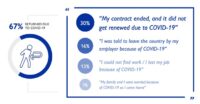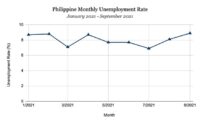Patricia Miraflores*
The ongoing repatriation of Overseas Filipino Workers (OFWs) due to COVID-19 was named the biggest in Philippine history by Foreign Secretary Teodoro Locsin Jr. who speculates it may even be the largest ever mass repatriation of citizens from a single country. During the pandemic, a one-billion peso fund was allocated to the Assistance-to-Nationals (ATN) Policy in aiding stranded OFWs who lost their jobs abroad, among other precarious situations. However, the ATN fund was quickly depleted due to the unprecedented number of OFW repatriations in 2020 and additional funding worth 820 million pesos was requested.
These nationally-funded repatriation schemes enabled the safe return of Filipino migrants who faced vulnerable conditions in their host countries. However, some criticized these policies for being counterproductive, having trapped aspiring OFWs and newly repatriated migrants in the Philippines. Returnees face even more precarious conditions at home than abroad, with 83% of OFWs having remained unemployed three months after returning. While predictive models have been proposed on the personal, economic, social, and political factors that influence Filipinos’ decisions to work overseas, most were based on the pre-pandemic context. Given the continuous developments in Filipino migration patterns during the pandemic, further studies are needed to evaluate the medium- to long-term effectiveness of repatriation policies. As such, evolving conditions and emerging factors from the time OFWs contemplate repatriation up to their actual reintegration in the Philippines should be considered.
Considering and reconsidering repatriation
OFWs are not unfamiliar with global health crises, having been exposed to epidemics and outbreaks of viral diseases such as SARS, Ebola, and MERS-CoV. However, none have impacted OFWs with the same magnitude as the COVID-19 pandemic in terms of unemployment, displacement, and other forms of precarity while based abroad. The infographic below depicts some key findings among the 8,332 repatriated OFWs interviewed by the International Organization of Migration as of March 16, 2020. While 67% of all respondents reported that their decision to return was primarily influenced by the pandemic, 23% intended to return regardless of the situation. Among those who answered the former, the most common reason cited was employment contract termination or non-renewal due to the economic downturn and escalating situation in the host country. Others were requested by their employer to leave due to the pandemic, whereas some were fired and/or unable to find employment. A smaller percentage reported that their family convinced them to return home for their safety.

Source: International Organization of Migration
Beyond economic reasons, it is important to remember that pandemic conditions and the corresponding policy responses of nation-states are highly dynamic. In the case of OFWs, the decision to repatriate will be further influenced and complexified by new developments in both their host and home countries. For example, half of the 80,000 unemployed OFWs who signed up for repatriation as of March 2021 withdrew their application after they were vaccinated against the COVID-19 virus. Indeed, the process of vaccinating non-citizens in traditional host countries such as the United States tends to be slower due to extra impediments. However, we can expect OFWs to factor these new options into their decision-making as vaccines, testing kits, and isolation facilities are becoming less and less inaccessible to refugees and migrants in many countries. As national policies evolve and become more inclusive of non-citizens, such changes may expand OFWs’ options and compel them to reconsider staying in their host countries.
Re-migration and the precarity of reintegration
Many OFWs who followed through with repatriation as of the second quarter of 2020 embarked on rather tedious reintegration processes in the Philippines. Upon arrival, the first step was to wait for their turn to get tested for COVID-19. Due to the overwhelming number of returning OFWs, the international airport in Manila faced backlogs in releasing test results. Only after receiving a negative test result can returnees proceed with a maze of government requirements before they are permitted to travel from Manila to their provinces. Some local government units denied the entry of returnees based on the stigma that they are potential carriers of the virus. Three months after their return, the majority of returnees’ situations remained precarious as they struggled to secure jobs and repay debts, and the crisis persisted into 2021 as unemployment rates remained high.


Source: Philippine Statistics Authority
Re-migration abroad remains the most attractive option for several returnees, as 48% of the IOM survey participants responded that they still intend to work overseas. Majority of them preferred to re-migrate to the same destination country they previously worked in. Meanwhile, only 34% expressed their plan to stay in the Philippines, whereas 2% intended to migrate locally and 15% were undecided. Despite funding three nationwide livelihood program sgeared towards reintegration, only 26% of the respondents were reported to have applied and received any type of government support. Low registration rates for repatriation aid were also recorded, reflecting the limitations of these national reintegration policies in meeting returnees’ needs and anticipating their precarious situations.
Common types of reintegration aid offered by the government include a one-time financial assistance funding of 10,000 pesos, starter loans for small businesses, and reskilling programs to enter new careers. Upon arrival, the initial funding of 10,000 pesos was quickly depleted as recent returnees faced unprecedented expenses due to delays in the repatriation process, on top of the fact that some were not compensated properly by their foreign employers before they returned. For those who planned to start a small business, concerns with capital and capacity-building became major obstacles. Although there are loan programs to support income-generating ventures, only 30% of returnees are able to apply for them since most are still recuperating from huge financial losses from repatriation. Lastly, some returnees experienced a huge mismatch between the supply and demand for their skills, leading to unemployment at home. This is especially pertinent for seafarers whose skill sets were developed to meet demands abroad. Although reskilling programs were implemented, shifting to a completely new career path at home demanded more expenses and capacities that returnees cannot afford. For instance, most jobs with decent pay were found in the call center industry. Newly hired call center agents in the Philippines are required to have adequate equipment and internet connection. They were also expected to have perfect grammar when speaking in English and, in most cases, an American accent. Since most seafarers worked in multicultural settings, they are less likely to develop such skills intended to meet the niche demands of the telecommunications market. Hence, remaining in the Philippines during the pandemic more often led to unemployment for many returnees.
On the permanence of return and reintegration
Although national programs were implemented to increase prospects for repatriation, the process of reintegration presents several challenges for already-precarious OFWs. On one hand, this exposed the limitations of reintegration efforts in countries reliant on export-oriented economic strategies. The lack of dignified labor and sustainable livelihood at home for repatriated OFWs reflects the human and social costs of designing a labor supply-and-demand system built around remittances. On the other hand, this also attests to the integral role of overseas migration to Filipinos’ survival, security, and identity, given the nation’s long history of international mobility. While the notion of permanent repatriation is fundamental to diasporic communities, “return” is often fluid in practice. This is especially true in the context of circular migration among precarious OFWs with a high tendency for re-migration.
When weighing the risks and rewards of circular migration during the pandemic, OFWs have to consider their economic realities and circumstances both at home and abroad. To strengthen reintegration policies in the Philippines, sharper focus is needed on creating self-sustainable means of livelihood for recent returnees. However, successful reintegration cannot work without a holistic restructuring of the export-oriented economic system. This entails confronting the deep-seated flaws of remittance dependency and the implementation of long-overdue economic reforms that will create a robust local job market.
Patricia Miraflores* is a graduate student pursuing a joint Master’s degree in M.A. Euroculture at the University of Groningen and Uppsala University. She is a recipient of the 2020 Erasmus Mundus scholarship award from the European Commission. Email: p.e.c.miraflores@student.rug.nl
